A pictograph presents the results of a survey using images, symbols or icons.
A pictograph can be presented in two ways: horizontally or vertically.
Horizontal pictograph:

Vertical pictograph:

The title of a pictograph always presents the subject of a survey.
The title indicates that this pictograph presents the number of animals that live on Cactus Street.

The categories specify what information is contained in the pictograph.
This pictograph shows the number of fish, cats, dogs and rabbits that live on Cactus Street.

In a pictograph, the data (results) are represented by images, symbols or icons. Each image represents a piece of data.
There are 4 images in the cat category. This indicates that there are 4 cats living on Cactus Street.

A pictograph presents the results of a survey using images, symbols or icons.
A pictograph can be presented in two ways: horizontally or vertically.
Horizontal pictograph:

Vertical pictograph:
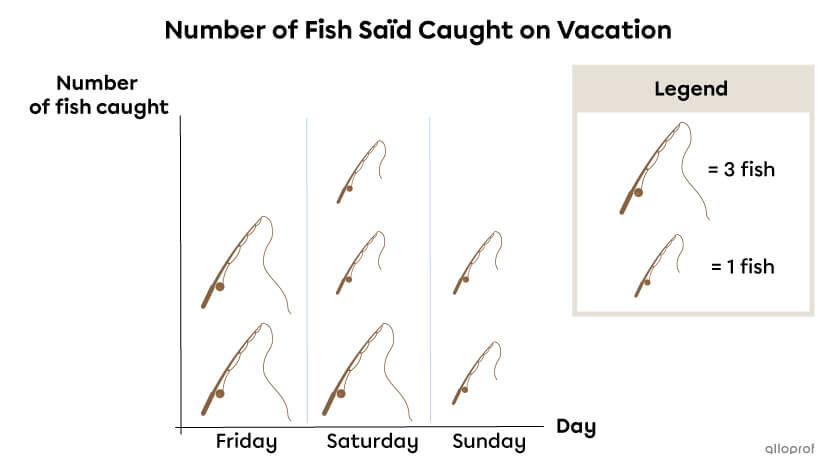
The title of a pictograph always presents the subject of a survey.
The title indicates that this pictograph represents the number of fish caught by Saïd during his vacation.

A pictograph has 2 axes: the vertical axis and the horizontal axis. Each axis has a label indicating what it represents.
In this graph, the vertical axis represents the days. The horizontal axis represents the number of fish caught.

The categories present the information collected in the pictograph.
The graph shows the number of fish caught on Friday, Saturday and Sunday.

In a pictograph, the data (results) are represented by images, symbols or icons. The legend specifies the value of each image.
The legend shows that the big fishing rod represents 3 fish and the small fishing rod represents 1 fish.

In some pictographs, half-symbols are used. Find the value of the whole symbol first, and then divide it by 2.
The legend indicates that a whole basket is equal to 4 apples. To find the value of a half-basket, divide 4 by 2.
4 ÷ 2 = 2
One half-basket equals 2 apples.
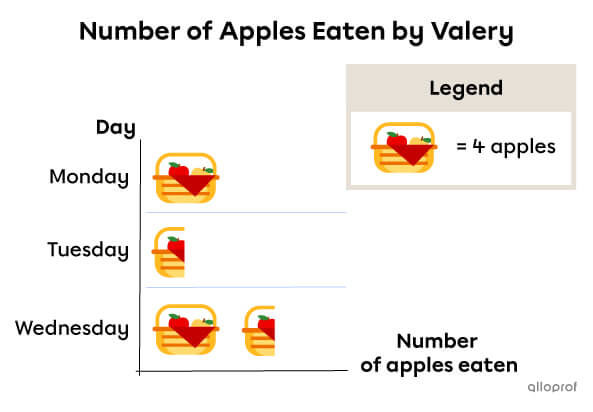
To interpret a pictograph, you must analyze all the parts of the graph while keeping the question that was asked in mind.
What is the least popular marine animal in this 3rd grade class?
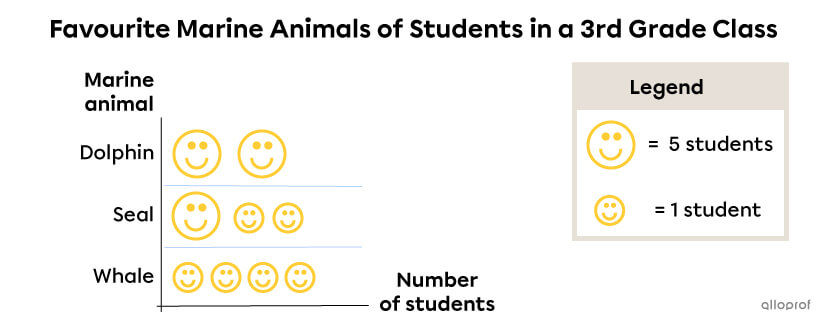
|
 |
|
 |
|
 |
In this 3rd grade class, the least popular marine animal is the whale.
How many balls does Jia have altogether?

|
 |
|
 |
|
 |
Jia has 6 balls in total.
A pictograph presents the results of a survey using images, symbols or icons.
A pictograph can be presented in two ways: horizontally or vertically.
Horizontal pictograph:

Vertical pictograph:

The title of a pictograph always presents the subject of a survey.
The title indicates that the pictograph represents the number of fish caught by Saïd during his vacation.
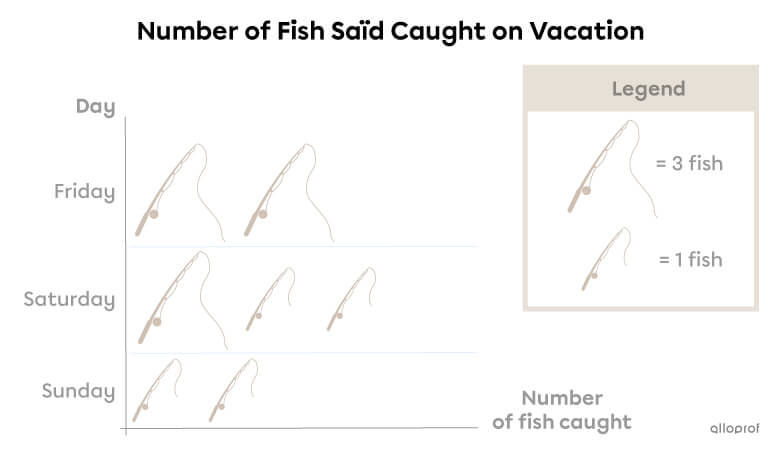
A pictograph has 2 axes: the vertical axis and the horizontal axis. Each of these axes has a label that indicates what it represents.
In this pictograph, the vertical axis represents the days. The horizontal axis represents the number of fish caught.
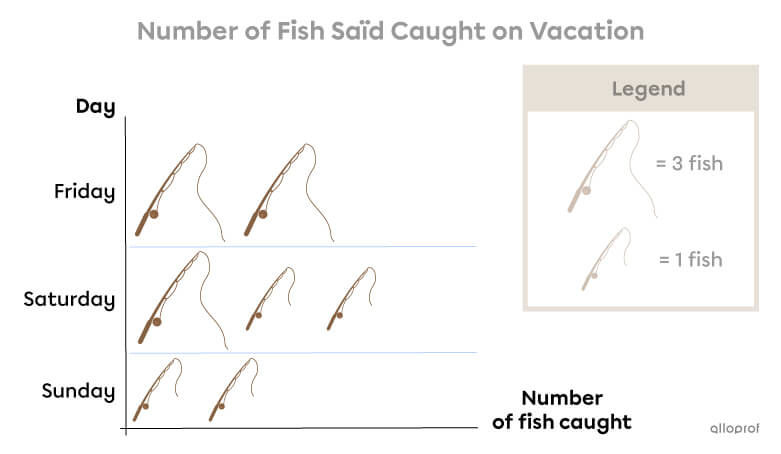
The categories present the information collected in the pictograph.
The pictograph shows the number of fish caught on Friday, Saturday and Sunday.

In a pictograph, the data (results) are represented by images, symbols or icons. The legend specifies the value of each image.
The legend indicates that the big fishing rod represents 3 fish and the small fishing rod represents 1 fish.
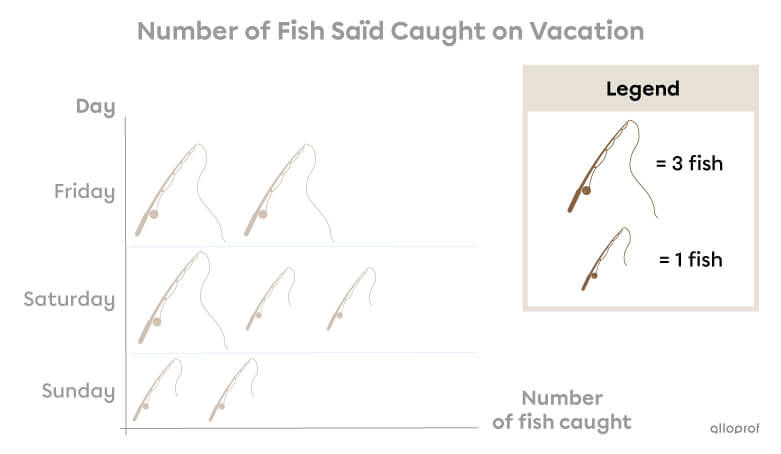
In some pictographs, half-symbols are used. Find the value of the whole image first, and then divide it by 2.
The legend indicates that a whole basket equals 4 apples. To find the value of a half-basket, divide 4 by 2.
4 ÷ 2 = 2
One half-basket equals 2 apples.

To interpret a pictograph, you must analyze all the parts of the graph while keeping the question that was asked in mind.
What is the least popular marine animal in this 3rd grade class?

|
|
|
|
|
|
In this 3rd grade class, the least popular marine animal is the whale.
How many balls does Jia have altogether?
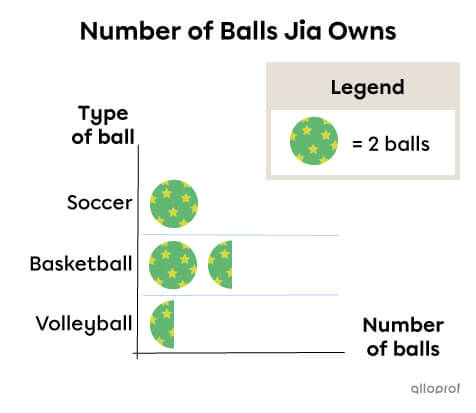
|
|
|
|
|
|
Jia has 6 balls in total.





